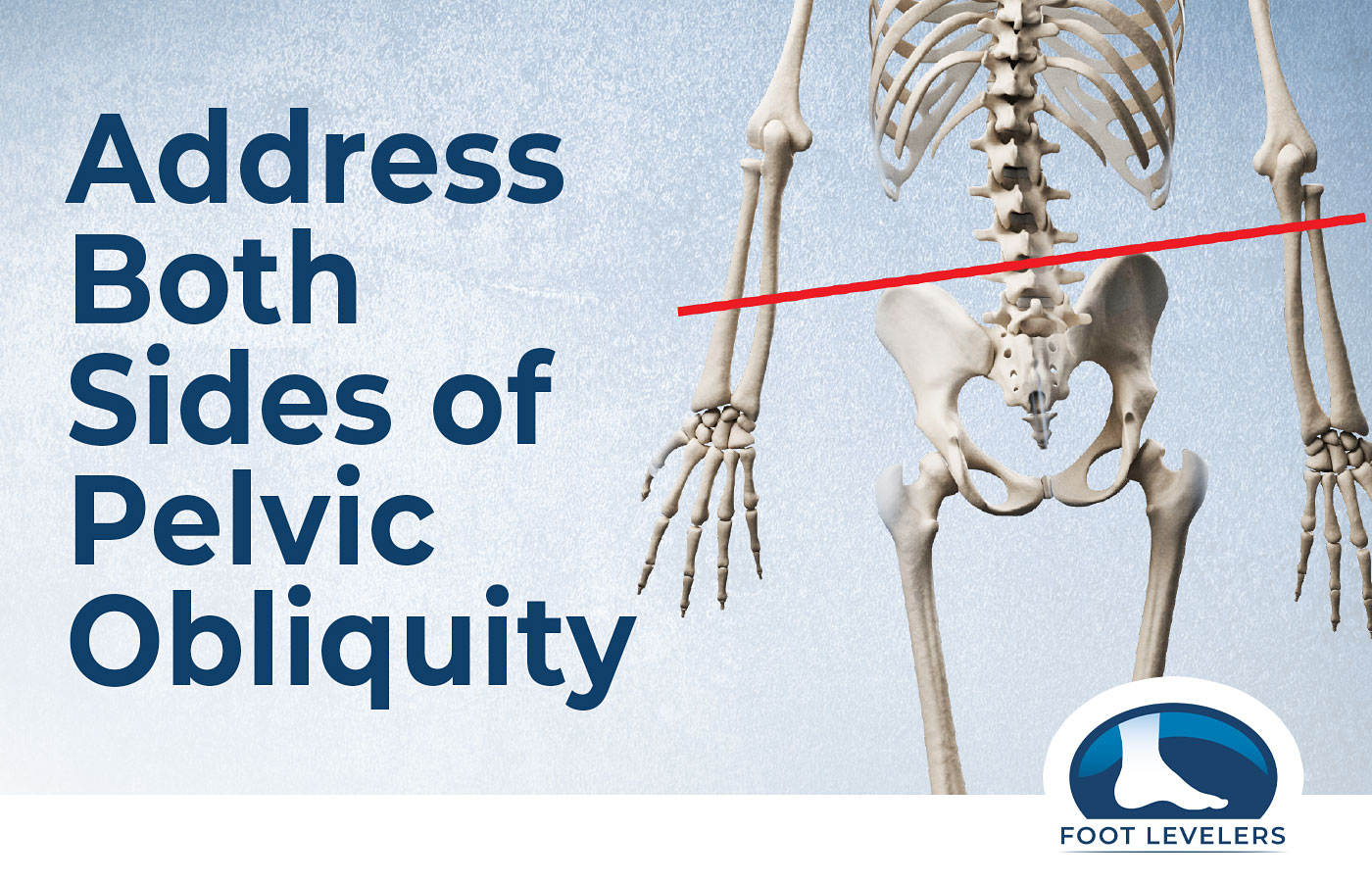
By Christine Foss, DC, M.S.ED., ATC, DACBSP, DACRB, ICSC
Identify the root causes of hip microinstability and develop a preventative treatment plan
Pelvic obliquity as demonstrated in the graphic above is best described as the unleveling of the pelvis. It can be caused by such things as leg length inequality, scoliosis, muscle imbalance, subluxation, or any host of congenital variants. Pelvic obliquity can also be caused by any combination of these conditions.
An interesting point about pelvic obliquity in the recent research is the raising interest in the surgical outcomes of total hip replacement surgery in the instance of pelvic obliquity1. The #1 surgery performed on the hip is a total hip replacement. Over 450,000 Americans undergo hip replacements every year; a number expected to increase as the population ages2.
As holistic healers, what if chiropractors could help correct pelvic obliquity before the kinetic chain is so fatigued in fault that a surgical intervention is needed? In other words, what if we catch it and treat it early enough to prevent surgery? Research tells us that a pelvic incidence angle (anteriorly tipped pelvis), will increase anterior hip pathology such as labral tears, femoroacetabular impingement and osteoarthritis significantly3.
The question is: what side of the obliquity are we fixing? Understanding the kinetic chain and the distal ramifications of this unleveling is where we need to begin. Pelvic obliquity is met with an anterior superior (AS) side and a posterior inferior (PI) side. The AS side of the pelvis will be the side that demonstrates a posterior superior femoroacetabular joint, femoral internal rotation, tibial internal rotation and hyperpronation. The AS side will also be the side that presents with a low shoulder on the ipsilateral side.
Targeting the source of pelvic obliquity
The posterior superior femoroacetabular joint in the AS pelvis is the position that predisposes the hip to such etiologies as: microinstability, labral tears, femoroacetabular impingement syndrome (FAI) and early onset osteoarthritis (OA)1,2. This AS position really sets the trajectory of the patient's future hip health. With correction of the AS side, it is probable that we can catch the progression of these etiologies.
One way to unpeel pelvic obliquity (in addition to chiropractic manipulation) is to level the pelvis from the ground up with a flexible custom orthotic that stabilizes all three arches of the foot. Not only will this enhance and support the adjustment, but it will also provide stability and help prevent injury with each step your patient takes. A flexible orthotic allows for the foot to progress through the normal phases of gait without fixing the subtalar joint in one position. This is more clinically aligned with the chiropractic philosophy of joint mobility.
Boost the effectiveness of your treatment with these additional steps
A second way to enhance our treatment is to institute a home exercise and stretching plan of the anterior hip capsule. In stretching out the anterior hip, we can reduce the angle of sacral incidence. This angle is also found to be responsible for increased FAI, OA and labral tears of the hip. Additionally, by stretching out the anterior hip we are facilitating the correction of the AS side of the pelvis.
We cannot however forget about the PI side of the pelvis. However, this side is met with its own issues and ramifications. The PI side of the pelvis will be the side of the high shoulder. The higher shoulder will be predisposed to serratus anterior inhibition. Serratus anterior inhibition lends itself to contralateral glute inhibition via the posterior sling. Glute inhibition also then sets the hip up for increased instability on the AS side. Therefore, the PI side of the pelvis feeds the AS pelvis ramifications of hip instability.
Pelvic obliquity is the mechanism for hip microinstability, future hip pathology and lower kinetic chain fault. Correction of both the AS and the PI side of the pelvis in is imperative for the kinetic chain to be fully unwound. Adding custom flexible 3-arch orthotics to the chiropractic adjustment and a corrective exercise plan will enhance and protect the adjustment as well as stabilize the patient with each step. This proactively supports healthy biomechanics and kinetic chain function, for optimal care success.
References
- Loppini M, Temporiti F, Furone R, Galli M, Grappiolo G, Gatti R. Static and dynamic pelvic kinematics after one-stage bilateral or unilateral total hip arthroplasty. HIP International. 2021;31(6):729-734
- The American College of Rheumatology
- Okuzu Y, Goto K, Okutani Y, Kuroda Y, Kawai T, Matsuda S. Hip-Spine Syndrome: Acetabular Anteversion Angle Is Associated with Anterior Pelvic Tilt and Lumbar Hyperlordosis in Patients with Acetabular Dysplasia: A Retrospective Study. JB JS Open Access. 2019 Jan 29;4(1):e0025. doi: 10.2106/JBJS.OA.18.00025. PMID: 31161147; PMCID: PMC6510466
Together we fix it, others don't.
Develop a successful hip obliquity treatment program using your expertise and Foot Levelers custom stabilization products and resources.
Build your protocol with our custom flexible 3-arch orthotics and Shoethotics® orthotic footwear to balance and stabilize the entire body. Our rehabilitation solutions are ideal for stretching exercises.
Explore Foot Levelers custom orthotics
Explore Foot Levelers Shoethotics® orthotic footwear
Visit the Foot Levelers Rehabilitation website
Watch Dr. Foss's Hip Tip Video.
Grow your practice with Foot Levelers custom stabilization solutions.